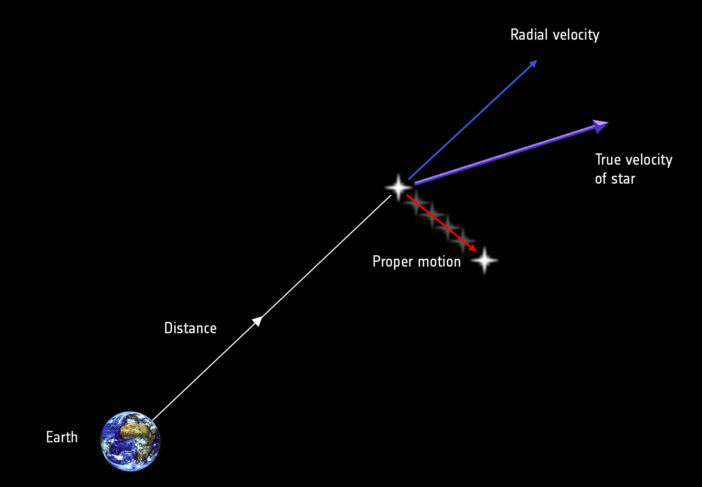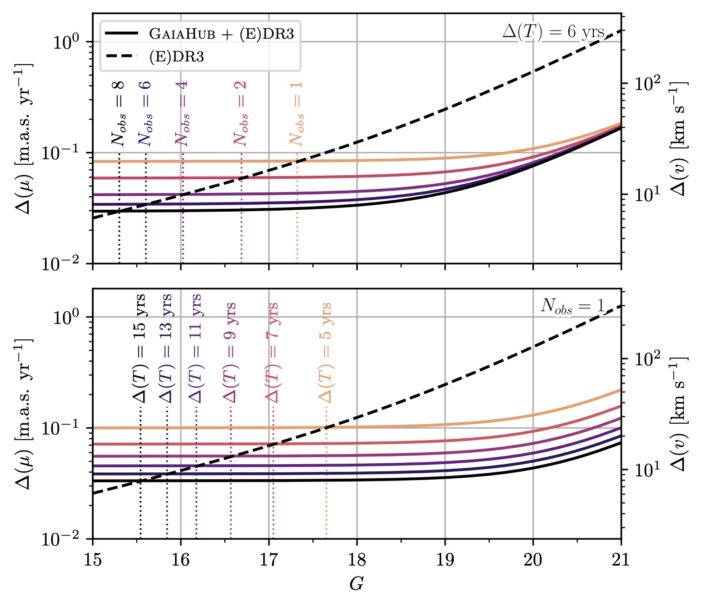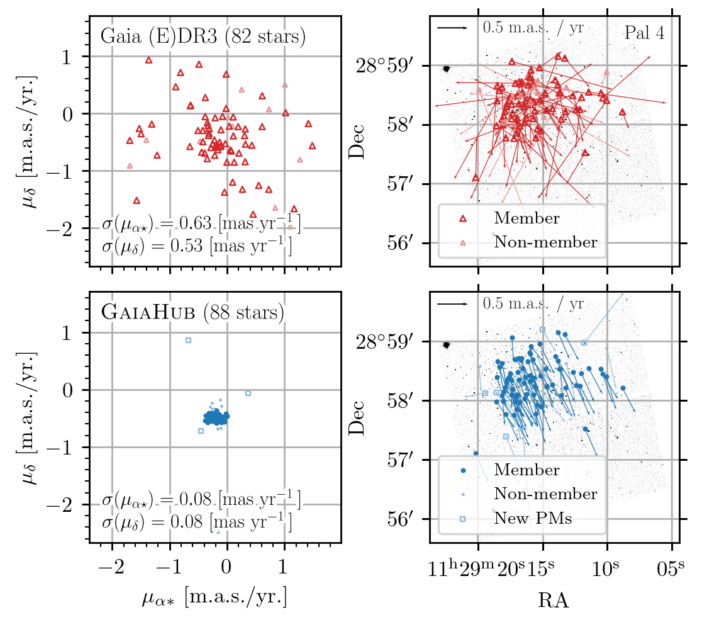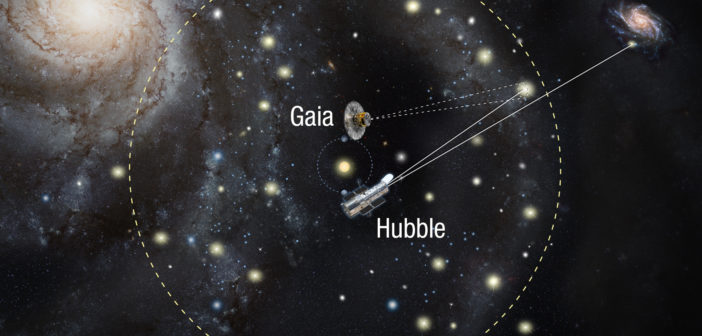Editor’s Note: Astrobites is a graduate-student-run organization that digests astrophysical literature for undergraduate students. As part of the partnership between the AAS and astrobites, we occasionally repost astrobites content here at AAS Nova. We hope you enjoy this post from astrobites; the original can be viewed at astrobites.org.
Title: GaiaHub: A Method for Combining Data from the Gaia and Hubble Space Telescopes to Derive Improved Proper Motions for Faint Stars
Authors: Andrés del Pino et al.
First Author’s Institution: Center for Studies of Astrophysics and Cosmology of Aragón (CEFCA) and Space Telescope Science Institute
Status: Published in ApJ
Intro: What Is Proper Motion and How to Find It
Stars in the night sky seem fixed, but they are all traveling through the Milky Way just like the Sun. Since objects in the universe travel in 3D space, we can separate their velocities into three components, as shown in Figure 1: one component is the radial velocity, which points towards or away from Earth, and the other two components come from the proper motion, which refers to motion in the plane of the sky. Radial velocity is usually measured by finding the redshift of the object’s spectral lines, and it can reach down to several kilometers per second in accuracy. Proper motion is much harder to measure.

Figure 1: An illustration of radial velocity and proper motion. [ESA/ATG Medialab]
However, Gaia data have two important shortcomings. Firstly, it is a small telescope and works better for bright stars. For faint stars, the astrometric errors rise rapidly. But if we are interested in a faraway system (e.g., a satellite dwarf galaxy of the Milky Way), all the stars will be faint. Using Gaia data alone, the velocity errors far exceed the true variation in the galaxy. The second issue is the time baseline. Given a constant velocity, stars will shift more if you wait longer between two observations. That is why the time baseline has a huge impact on proper motion accuracy. Gaia has only been operating and recording positions for three years. If there is a way to increase the time baseline, that can also improve the proper motion measurements.
How to Measure Proper Motions Better?
Prior to the launch of the Gaia space telescope, the workhorse in astrometry studies was the Hubble Space Telescope. Hubble data can solve both of the issues mentioned above; it can observe much fainter stars, and it’s been taking data since 10–15 years before Gaia was even launched. If there is a way to combine these datasets, the time baseline for the proper motion measurements could be extended by a factor of 4–6. As shown in Figure 2, even adding one Hubble image can push down the errors by a lot for faint stars (G magnitude > 17). That is precisely what the authors of today’s article did.

Figure 2: The expected proper motion uncertainties as a function of the magnitude of stars. In both panels, nominal errors of Gaia Early Data Release 3 are shown by a black dashed curve. The top panel shows the impact of using one or more Hubble images, taken at the same epoch, June 2011. The bottom panel shows the impact of using just one Hubble image taken on different years (the typical baseline found in the data is ~11 years). [del Pino et al. 2022]
Combining Hubble and Gaia
The authors of today’s article developed a software called GaiaHub, which compares the positions of the stars measured with Gaia with those measured with Hubble. The first step is to measure positions of stars in Hubble data. This is a well-established process that takes into account the instrument distortions and time variations, and it achieves a typical accuracy of 0.25–0.5 milliarcseconds.
Then comes the hard part: the star positions need to be matched to Gaia measurements. Since the two datasets are more than 10 years apart, establishing a common reference frame between the two is the key challenge. The software offers three different algorithms: when there is a large number of randomly moving stars, it matches the average positions of all stars; when the stars have some coherent motion, the proper motion can be modeled iteratively so that the coherent motion is removed; or, finally, if there are many contaminant stars, the code can also set up the reference frame from co-moving stars. The improved accuracy with Gaia and Hubble data can be seen in Figure 2 as a function of the magnitude of the stars.
Results
So how does this software perform on real data? Figure 3 shows the drastic improvement you get from combining Gaia and Hubble data. In this example, proper motions are used to identify member stars of a globular cluster Palomar 4. The stars in a cluster should move together, which means they should all have similar proper motions. The left column in Figure 3 shows the proper motion in as a function of on-the-sky coordinates, right ascension (RA) and declination (Dec), measured by Gaia alone (top panel) and GaiaHub (bottom panel). The proper motion measurements from GaiaHub clearly have much smaller scatter and allow for a cleaner selection of member stars. This is confirmed by the right column, which shows the sky positions of the selected stars and their proper motion vectors. In the Gaia selection, the lines indicating the direction of motion point all over the place, while GaiaHub results show very coherent motion. Given that member stars should move together, GaiaHub successfully picks out the likely members of Palomar 4.

Figure 3: Comparison between the results obtained using Gaia and GaiaHub for the Palomar 4 globular cluster. Left column: proper motion in RA vs. Dec, measured by Gaia (top panel) and GaiaHub (bottom panel). Right column: sky positions of the stars with the projected proper motion vectors. [del Pino et al. 2022]
As with all research techniques, GaiaHub has its limitations. Due to the cross matching, GaiaHub relies on stars that overlap in both datasets. That means the field of view is limited by the smaller of the two, which is Hubble. The magnitude of the stars that can be detected by both telescopes is also limited, since bright stars are often saturated in Hubble images. Both of these factors mean that GaiaHub works best at an intermediate distance, where the Hubble field of view is large enough to cover the globular cluster and the brightest stars are faint enough to not be saturated.
To summarize, GaiaHub improves the proper motion measurements by a factor of ten. More precise proper motions at fainter magnitudes allow us to study the kinematics of many stellar systems around the Milky Way. This public software will be a great resource for the astronomy community!
Original astrobite edited by Katya Gozman.
About the author, Zili Shen:
Hi! I am a PhD student in Astronomy at Yale University. My research focuses on ultra-diffuse galaxies and their globular cluster populations. Since I came to Yale, I have worked on two “dark-matter-free” galaxies NGC1052-DF2 and DF4. I have been coping with the pandemic and working from home by making sourdough bread and baking various cookies and cakes, reading books ranging from philosophy to virology, going on daily hikes or runs, and watching too many TV shows.
